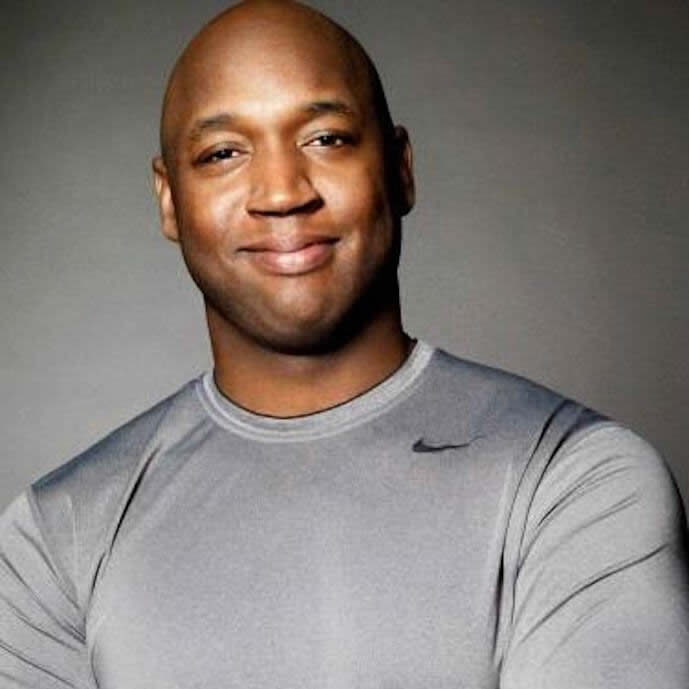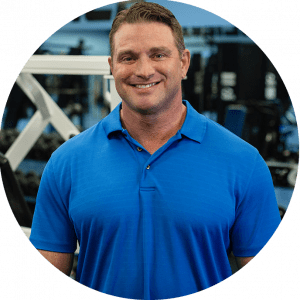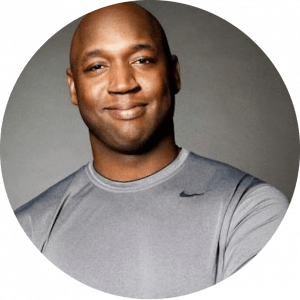

FREE E-book worth £19.95
Free for our readers!!!
Enter email to have it sent directly
We will not use the email for spam
Enter Email To Download
[mautic type="form" id="3"]
Top 10 Best Exercises To Build Muscle Quickly
So much to do, so little time. This is probably the standard complaint of 21st century life, in spite of the fact that technology is taking over so many of what used to be daily chores. The irony of this situation is that for many people, our increasing reliance on technology means that we use our muscles less in daily life and hence makes it even more important that we find (make) time to go to the gym and use weights to give our muscles a good workout.
For some people this is an enjoyable activity, for others it’s something they do because they feel they need to. In either case, however, going to the gym or even using a home gym is probably something people need to fit in amongst many other activities and hence people want to get the best value for their time. With this in mind, we’ve compiled what we think are the 10 best exercises to build muscle quickly.
Barbell Pullover
 Lie on a flat bench, hold the barbell over your chest, gripping it so your arms are a shoulder width apart. Your arms need to stay bent throughout this exercise. Inhale, and slowly move your arms over your head until you feel a stretch in your back and chest. Exhale and slowly move the barbell back to the starting position. Hold it there for a second.
Lie on a flat bench, hold the barbell over your chest, gripping it so your arms are a shoulder width apart. Your arms need to stay bent throughout this exercise. Inhale, and slowly move your arms over your head until you feel a stretch in your back and chest. Exhale and slowly move the barbell back to the starting position. Hold it there for a second.
Muscles worked - mainly the laterals also upper pectorals, teres major and triceps
Hint - for this exercise you want to use a weight which allows you a good stretch, while still allowing you to keep your hips down.
Bench Press
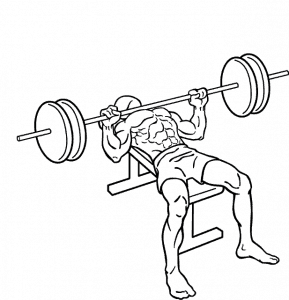 Lie on a flat bench. Grip a barbell with a medium-width grip, this means that when your arms come down to the bench, at the midpoint of the movement, your elbow should form a right angle linking the bar and the bench. You may find that the easiest approach is to adopt this position first, so you get the width right and then move into the starting position.
Lie on a flat bench. Grip a barbell with a medium-width grip, this means that when your arms come down to the bench, at the midpoint of the movement, your elbow should form a right angle linking the bar and the bench. You may find that the easiest approach is to adopt this position first, so you get the width right and then move into the starting position.
To move into the starting position, lift the barbell off the rack and hold it directly over your chest with your arms almost locked. Inhale and lower the bar slowly until it nearly touches your chest. This is when your elbow should make the right angle. Pause for a second and then exhale and raise the bar back to the starting position.
Muscles worked - pectorals, anterior deltoids, triceps
Hint - if you want to take the humble bench press to the next level, then the way to do so is to pull your shoulders down so that you can arch your back slightly. Please note, this is only a slight arch so that the chest muscles are worked a bit harder. You still need this exercise to be a workout for your muscles rather than your spine.
Bent Over Barbell Row
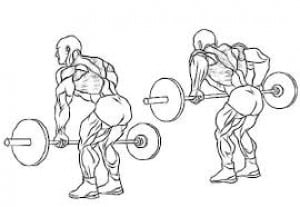 Grip a barbell with your fingers pointing downwards (i.e. towards the floor), bend your knees slightly and allow your torso to come forwards naturally. Keeping your head up and your back straight, come up through your knees and waist until your back is almost parallel to the floor and your arms are (almost) perpendicular to it.
Grip a barbell with your fingers pointing downwards (i.e. towards the floor), bend your knees slightly and allow your torso to come forwards naturally. Keeping your head up and your back straight, come up through your knees and waist until your back is almost parallel to the floor and your arms are (almost) perpendicular to it.
Remember your knees stay bent, they just move from a full bend to a slight bend. This is your starting position. Before you begin the exercise proper, remember that you need to keep your head up, i.e. facing forward, so that your back stays straight. Ignore the barbell, or at least ignore what it looks like.
Exhale and lift the barbell towards your torso, keeping your chest steady. Keep your elbows tucked in (and always at least slightly bent), the weight should be on your forearms. When you have lifted the barbell as far as you comfortably can, squeeze your back muscles and hold for a second before lowering to the starting position.
Muscles worked - laterals, rhomboids, mid-trapezius, rear deltoids, lower back, biceps, brachialis, forearms
Hint - once you master the basic exercise, you can adjust your grip to target different sets of muscles. A wider grip will target the back, whereas a narrower one will target the laterals.
Deadlift
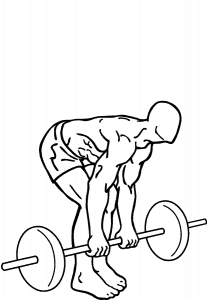 The deadlift is a deceptively simple exercise and it’s worth deconstructing it to understand how it works and hence how to perform it safely. Before you start thinking about picking up a weight you can and should practice the basic movement.
The deadlift is a deceptively simple exercise and it’s worth deconstructing it to understand how it works and hence how to perform it safely. Before you start thinking about picking up a weight you can and should practice the basic movement.
Ideally you should have someone watch you but otherwise you will probably find using a cellphone or camera to record yourself than try to watch yourself performing the movement in a mirror, although this is better than nothing.
What you need to understand about a deadlift is that the movement comes from the hips. To practice the movement, stand about an arm’s breadth from a wall, with your feet shoulder width apart and pointed forward.
Keep your feet steady and move your butt backwards until it touches the wall with the result that your back comes forwards (staying straight). The movement comes from your hip so although the top of your leg will move with it and your lower leg may have to move slightly, any lower leg movement should be minimal.
Once you can perform this movement confidently, you’re ready to add weight and turn it into a deadlift.
When you approach the bar you want your feet in the centre of it, about hip-width apart.
Bend from the hip and grip the bar with your hands about shoulder-width apart. In other words, if someone is looking at you from the front, your hands should be just at the sides of your feet, albeit also in front of them.
Grip the bar with your fingers pointing down towards the floor.
Inhale and then lower your hips, flexing your knees as necessary, until your shins make contact with the bar. Press down through your heels, pulling up through your hips and hence your knees to raise your body and the weight.
When the bar is over your knees, pull it back towards your chest as you simultaneously push forwards with your hips to bring them into the bar. Pause and then lower the bar by lowering your hips and easing it towards the floor.
Muscles worked - lower back, quadriceps, hips, glutes, hams, upper trapezius, forearms
Hint - The if you’ve seen powerlifting competitions then you may have noticed that the deadlift is performed at the end, hence if your aim is to train for powerlifting competitions then ultimately you will need to get into the habit of performing deadlifts when fatigued.
This is generally the only situation in which it makes sense to perform a deadlift when tired. Usually you want to do your deadlifts right after your warm up when your body is at its freshest. You also want to keep the weight level down to a point where you can perform the lift with good form. This is far more important than trying to impress everyone with how much weight you can lift.
As a final point, deadlifts are a tough exercise, only make them tougher if you have a good reason to do so. Deadlifting off the floor is much tougher than deadlifting off a platform, so, in the beginning at least, stick with the platform.
Dips
 Grasp two parallel bars approximately shoulder width apart. Bend your knees so your feet are off the ground and support your entire weight with your arms, which should be almost straight. This is your starting position. Keeping your feet off the ground, bend your elbows until they almost form a right angle, pause and raise yourself to your starting position.
Grasp two parallel bars approximately shoulder width apart. Bend your knees so your feet are off the ground and support your entire weight with your arms, which should be almost straight. This is your starting position. Keeping your feet off the ground, bend your elbows until they almost form a right angle, pause and raise yourself to your starting position.
Muscles worked - pectoralis, triceps, and anterior deltoids.
Hint - lean forward to target the chest, stay upright to target the triceps.
Leg press
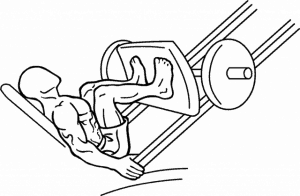 Sit on the machine, put your feet onto the weight, lower the safety bar holding the weight and then extend your legs until they are almost straight. This is your starting position. Breathe in and slowly lower the platform until your knees form a right angle, pause and return, slowly to the starting position. Throughout this movement, you will be channeling energy through your knees.
Sit on the machine, put your feet onto the weight, lower the safety bar holding the weight and then extend your legs until they are almost straight. This is your starting position. Breathe in and slowly lower the platform until your knees form a right angle, pause and return, slowly to the starting position. Throughout this movement, you will be channeling energy through your knees.
Muscles worked - quads, hams, hips and glutes
Hint - Vary the distance between your feet and/or the angle of the bench to target different sets of muscles.
Pullup
 Grab the pullup bar using your choice of grip, bend your knees, exhale and pull your torso up until your head is above your hands, pause. Inhale and lower yourself back to your starting position.
Grab the pullup bar using your choice of grip, bend your knees, exhale and pull your torso up until your head is above your hands, pause. Inhale and lower yourself back to your starting position.
Main muscles worked - lats, rhomboids, mid-traps, read-delts, biceps, brachialis, forearms
Hint - vary the width of your grip and the angle of the torso to target different sets of muscles
Seated dumbbell shoulder press
 Sit on a bench which has a back support, such as a military bench press. Hold a dumbbell in each hand and sit the bell part on top of your thigh, one on each side. Use your thigh to push the dumbbells up rotating your hands so your fingers are facing forwards. Your upper arm should be parallel to the floor and your elbow almost at a right angle. Exhale and raise the dumbbells until they touch above your head. Pause and then inhale and return to starting position.
Sit on a bench which has a back support, such as a military bench press. Hold a dumbbell in each hand and sit the bell part on top of your thigh, one on each side. Use your thigh to push the dumbbells up rotating your hands so your fingers are facing forwards. Your upper arm should be parallel to the floor and your elbow almost at a right angle. Exhale and raise the dumbbells until they touch above your head. Pause and then inhale and return to starting position.
Muscles worked - shoulders, triceps, upper pecs
Hint - remember this is about correct movement rather than brute force. It’s better to use a lighter weight and do the movement correctly than to try to use more weight and do it incorrectly.
Squat
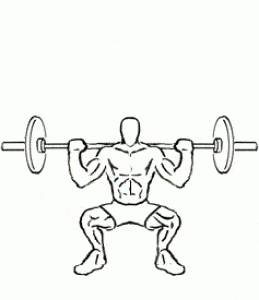 Support the barbell on your traps (just behind your shoulders), grip it with the palms of your hands underneath and your fingers curled over the top. Legs should be hip-width apart, turn your feet out as far as you need to feel comfortable. Knees are slightly bent to begin with.
Support the barbell on your traps (just behind your shoulders), grip it with the palms of your hands underneath and your fingers curled over the top. Legs should be hip-width apart, turn your feet out as far as you need to feel comfortable. Knees are slightly bent to begin with.
Exhale and lower your body from the knees until you feel your upper legs touch your lower legs. Keep your back straight and your butt tucked in, instead let the knees come forward, making sure that they stay over your feet (for balance). When you feel the two halves of your legs make contact, pause, inhale and return to starting position.
Muscles worked - quads, hams, hips, glutes, lower back
Hint - again this is all about range of motion rather than loading the bar. Keep your reps steady and controlled, then add more weight if you feel it appropriate.
Upright row
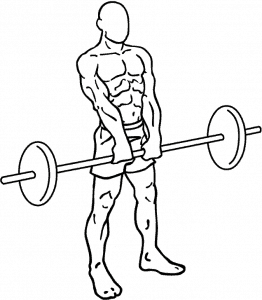
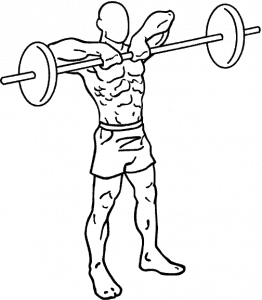 Grasp a barbell using an overhand grip, in other words your fingers point towards the floor but your palms are towards you. Keep your feet about hip width apart. Raise the bar to rest on your thighs so that your elbows are slightly bent.
Grasp a barbell using an overhand grip, in other words your fingers point towards the floor but your palms are towards you. Keep your feet about hip width apart. Raise the bar to rest on your thighs so that your elbows are slightly bent.
Exhale and raise the bar up to shoulder height, keeping it close to your body. The power comes from your shoulders through your elbows and hence your elbows should always be higher than your forearms. Pause, inhale and lower the bar to the starting position.
Muscles worked - shoulders, traps, biceps, brachialis, forearms
Hint, make your grip wider or closer to target different muscles.

